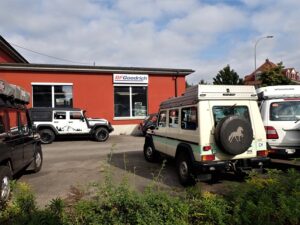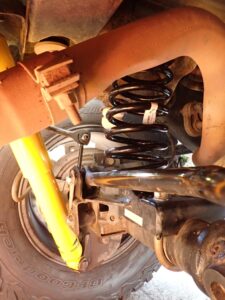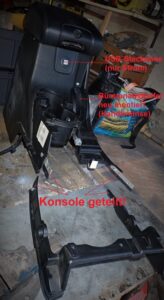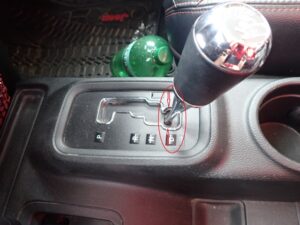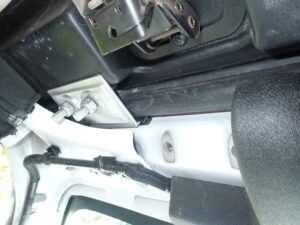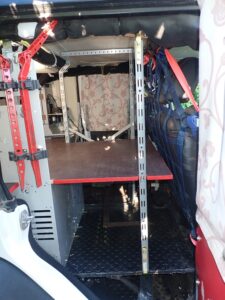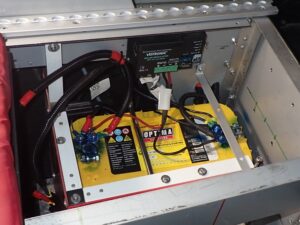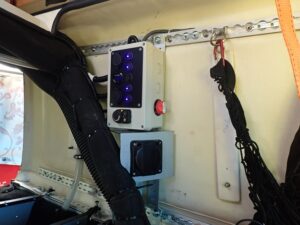(The information is listed consecutively and contains some very interesting details. Just scroll through for more details).
4 April 2024 / Tucson (USA/AZ) / Km 183’822
Damaged rear wheel bearing > Gearbox failure
Already on the Baja California at a mileage of around 178,000 kilometres, the yellow ABS malfunction lights began to light up more and more frequently. At first it was all a bit worrying, but the car drove without any problems, except that the cruise control no longer worked when the ABS fault light/ESC fault light was illuminated. In the morning or after a longer break everything was fine, only after a certain distance and uneven road surface, i.e. on gravel roads, did the fault return.
Note: At first, the white indicator light of the drive-off aid flashed 2-3 times, followed by the ABS and ESC malfunction.
This was later followed once by an engine block fault. When reading out the many faults, there was also an indication that the transmission speed sensor was faulty.
The red brake malfunction light came on once in Mexico and 2-3 times in the USA. Nobody has yet been able to explain to me why this warning light came on. But as soon as it lights up, the automatic transmission follows illogical shift commands and the torque converter may no longer close the lock-up. In any case, we were able to reset this fault with the scan software and continue driving.
In consultation with Peter Pauli (Allrad Pauli/Allgäu), he recommended checking the rear wheel bearings for play and, if necessary, replacing the wheel bearings as soon as possible, which is not easy in Mexico/Baja California. In any case, the rear bearings had axial play, I couldn’t detect any radial play.
In Tucson, after the previous experience (travel report > worst case), we had the rear wheel bearings replaced by a specialist garage. The tapered roller bearings had some signs of damage on the running surface. In addition, the outer rings of the roller bearings were turning in the axle housing, which was due to poor manufacturing quality on the part of Jeep.
Due to this axial play, incorrect signals were always sent to the various computers, which in turn led to strange reactions from the car.
During disassembly, the workshop also discovered defective or worn sensors and grinding marks on the encoder rings. This wear is not only due to axial bearing play, but can also be caused by muddy water and dust. Apparently a typical Jeep problem!
To prevent the outer bearing rings from turning any further, the workshop roughened the bearing seat slightly and glued the new bearings into the seats of the axle using Loctide/medium-strength adhesive.
The workshop also recommended that I reduce the vehicle weight, which is not exactly easy with a touring vehicle, or install a more robust axle from Terraflex.
The encoder rings were cleaned at the rear and new wheel sensors were fitted.
At the same time, the rear brake discs were replaced as they were far below the thickness recommended by Jeep.
Tip from Peter Pauli; replace the wheel bearings every 100,000 kilometres as a preventative measure for a heavy vehicle with an original axle, according to the motto; prevention is better than cure 😉
10 January 2024 / Santa Paula (CA) / Km 173’472
Changing the lock (latch) at the rear door
The lock on the rear door had been causing us some concern for some time and at times the opening mechanism jammed. Dust and general wear and tear severely restricted the lock in its intended function. Especially as the mechanical opening mechanism from the inside was more of a “tinkering” job than a professional solution, I worked hard to find a better solution.
The lock (latch) on the rear door (gate) is the same type as the one on the right front side door, which means that there should also be a different opening solution.
In Santa Paula, I replaced the entire lock and relocated the cable pull of the inner opening to the swivel lever, which is intended for the inner opening, i.e. the improvised “tinkering” with the mechanical outer opening was no longer necessary.
In addition, the cable was firmly connected to the rear door using an adjusting screw from a bicycle brake handle.
I was very positively surprised by the change and the opening actuators work perfectly.
22 November 2023 / Santa Paula (CA) / Km 173’472
General maintenance before storage / jammed brake caliper guide pins.
During the last maintenance work before storage (Storage Santa Paula), I noticed a jamming of the brake caliper guide pins on the front brakes. On the left, the upper pin was jammed and could only be released with great effort. On the right, the lower guide pin was jammed, but could still be easily removed with a tool.
After cleaning and lightly sanding with sandpaper, I was able to refit the newly lubricated bolts and the front callipers moved properly again.
I lubricated the rear right-hand brake calliper when changing the left-hand support in Flagstaf and both brake callipers move as expected.
Apparently a weakness in the Jeep brakes!
Surprisingly, the rear brake pads are very worn and are a sign that there are very steep roads in the USA where even engine braking in first gear is not enough. The three and a half tonnes gnaw away at the brake pads accordingly. 🙁
However, the on-board computer calculated the engine maintenance according to the American road conditions and the expected request for an oil change was not yet triggered. The various oils will therefore only be replaced in the new year if the required lubricant for our diesel engine is available. Apart from the engine, all other parts for our Jeep are readily available and the oil filter for the engine was brought to us by friends from the PanAm tour in Germany 😉
14 November 2023 / Pop-up roof / tent fabric is coming apart!
At the end of 2020, we bought a new awning for the pop-up roof from the manufacturer of our Gazell (camping kit for Jeep Wrangler JKU), as the rubber coating was coming loose in many places on the tent fabric and the fabric was leaking in places when it rained.
After just over 2 years of daily use, the rubber coating on the new awning also came loose in various places and the support fabric was exposed. Moisture pressed through the fabric into the interior of the pop-up roof.
We sealed the larger leaks with “Seam Grip” in the hope that the tent would continue to be watertight and we would stay dry. 🙂
2 October 2023 / Medford, Oregon/USA / Km 166’112
Tyre change
After around 55,000 kilometres on South, Central and North American roads, the tyre tread depth was still around 4.5 mm. Actually still almost good, but the increasingly frequent punctures and the impending winter, as well as the high sales tax in California, were the reason for changing the tyres in Oregon, where no sales tax is charged.
However, it took a while before we found the right tyre shop. The abundance of off-road and A/T tyres on offer in the USA is immense and every shop wants to sell the tyres to the customer where they can make the most profit. In any case, we had to drive to several tyre shops until we ordered the tyres we wanted and had them fitted.
(You may also want to read the story in the travelogue “Going south – to San Francisco”, where the complicated ordering process at Walmart/Oregon is also mentioned).
8. September 2023 / 162’161Km
ABS malfunction
Shortly before reaching Yellowstone National Park, the ABS malfunction occurred for the first time. However, it disappeared automatically after a short distance. After that, the fault occurred more and more frequently at regular intervals, but disappeared again after a short distance. We were never able to read out the fault data in a targeted manner, as the fault disappeared immediately when the diagnostic device was connected.
On the date mentioned above, we had the first opportunity to read out the current fault and diagnose the fault codes from the left rear wheel (C1020 + C1027). Unfortunately, the codes didn’t tell me (Tom) much, but I suspected some kind of faulty contact in the supply line.
I didn’t find a bad connection, but I removed the ABS sensor on the left rear wheel and was a bit surprised about the grinding marks on the sensor, sensor wheel side. The sensor wheel also showed slight signs of wear on certain tooth flanks. The wheel bearing play on the rear wheel was in the normal range according to my assessment, i.e. no excessive bearing play.
When reassembling, I made sure that there was more clearance between the sensor wheel and the sensor.
Exactly 865Km there was no malfunction of the ABS and everything worked properly. Then, while reversing off-road, the ABS malfunction occurred again on the rear wheel.
Again I examined the left rear wheel and was surprised at the slight wheel bearing play. Was this the cause of the ABS malfunction, i.e. the wheel bearing play was touching the sensor? I guess we have to pay more attention to our wheel bearings and replace the bearing as soon as possible. 🙁
31. August 2023 / 160’368Km // Kamiah/Idaho
Starter battery failure
Since the last days the starter battery announced its end of life. In the morning, the engine could only be started with the help of the auxiliary battery or the on-board battery. Now it was finally over; even for the warm engine, the starter would no longer engage and do its job. The starter battery definitely had no more juice!
In Kamiah /ID we got a suitable battery at NAPA, as we know there are no spare parts for our diesel jeep in North America, and after successful installation in the car park, everything worked again as desired.
July 2023
July 22, 2023 / 152’757 Km // Reno, Nevada
Oil and universal joint change front axle
Our Jeep was due for several service jobs. For these we went to an official dealer. Unfortunately only the engine oil could be changed. For all other work like changing the oil in the differential gears and for reduction gears we should have booked an appointment in advance. The change of the engine oil was necessary, the other transmission fluids should, according to the maintenance book and normal driving, still do their job until the next inspection date.
Interestingly, since the oil change in Reno, we have had to add more engine oil! Whether it’s due to the long driving distances; we don’t know.
Additionally, I wanted to have the front left universal joint replaced at the Jeep dealer in Reno. Jeep only sells the complete inner shaft for $750.00 and this repair would have required an appointment as well.
The storeman at the Jeep repair shop referred us to a specialized driveline repair shop that only replaces the defective parts, which in our case was the universal joints. Due to the vacation season, I had to remove the shafts myself, bring them to the workshop and then reinstall them. The disassembly as well as the reassembly of the shafts was very demanding for me (Tom).
For $275.- the universal joints on both sides were replaced with original spare parts and the replacement of the joints themselves was done in fifteen minutes.
After this work, the drive shafts on the front axle initially lost oil on both sides, but this subsided after a few hundred miles and no additional oil needed to be added to the differential.
Flat tires due to screws and nails
We have already driven thousands of kilometers through the wide world and never had any major problems with our tires. Apart from the sideways slashed tire on Gran Canaria (driving error) we never had any problems with our tires.
But since we are on the road in the USA on the “backroads”, we had to reach more and more to our repair kit for tires. Besides nails of all sizes, screws of all kinds were stuck in our tires and caused leaks.
Although the tires still have enough tread for normal driving, the lack of tread height could favor the puncture susceptibility, but on the American back roads sometimes really a lot of mill, or nails and screws lying around. Even they – the Americans – often stand on the side of the road with flat tires.
June 2023
35’000 kilometres through South and Central America to the USA
Yes, our Jeep managed this ordeal on the South and Central American roads with flying colours. Even at over 5,000 metres above sea level, the turbo diesel did its job to our complete satisfaction, while we were already gasping for air.
On the part of the vehicle control system, only the exhaust gas recirculation was programmed out and the plug connection to the corresponding valve was disconnected (O-M Technik/Gruse). The diesel particulate filter remained active and never presented us with any major problems, even with poor quality diesel. On the advice of Peter Pauli (Allrad Pauli/Oy-Mittelberg) we drove the engine at high altitude as well as on flat stretches always in the medium rpm range, i.e. around 2’000 rpm out of a maximum of 4’000 rpm.
In Argentina we had the engine oil changed (see special article!). I then changed the diesel filter myself. In addition to changing the diesel filter, I also used a special nozzle cleaning fluid, so that the system up to the injection nozzles was cleaned again from the high sulphur content in the fuel.
Apart from the regular vehicle checks and checks of the oil levels in the differential gears as well as the reduction gear, there were no major technical problems.
Unfortunately, the oil level in the automatic transmission could never be checked; the European diesel models do not have a corresponding dipstick for checking the oil and there is no workshop in South/Central America that has one available. As a result of the long driving distances and warm temperatures, I suspect – purely subjectively – that the oil level was no longer in the optimum range at the end of the journey.
In Mexico, we replaced the old on-board battery – not to be confused with the starter battery – as it could no longer supply the necessary energy for the constantly running cool box at higher outside temperatures. We replaced the large AMG battery with two small AMG batteries and thus have 35Ah more battery capacity.
Otherwise; up to the USA everything was really fine and in contrast to other participants of our group tour we really had no major technical problems. The pendulum of the perhab rod on the front axle slipped away at Ushuaia/Feuerland could be repaired on the way and an additionally installed washer keeps the pendulum in the right place since then.
Whether it was luck or the general quality of the vehicle; we don’t know!
Only in the USA, where the necessary spare parts were available, was the front right wheel bearing replaced, new brake pads fitted and the adapter to the brake cylinder replaced at the rear left. The guide pin of the brake adapter was blocked and could no longer be moved.
On the front propshaft, the sealing rubber on the CV joint came apart and the joint got a lot of dust and dirt, so that the play increased every day. Jeep wanted to sell me a whole propshaft for about $1’200. In the aftermarket I finally found the right spare part for a fraction of the amount and probably still have the better CV joint.
After this work, all of which I did myself, I finally set off on a great voyage of discovery in the southwestern states of the USA.
August and september 2022
Repairs and maintenance
 At the end of August our Jeep was put through its paces at Allrad Pauli in Buchloe – a specialist for Jeep Wranglers. Finally, our mobile home must not only pass the Swiss technical inspection, but also master for the next x-thousand kilometers without major problems in South America. Anyway, the 85’000 kilometers over “hill and dale” left their marks and we did not always spare the fully loaded car.
At the end of August our Jeep was put through its paces at Allrad Pauli in Buchloe – a specialist for Jeep Wranglers. Finally, our mobile home must not only pass the Swiss technical inspection, but also master for the next x-thousand kilometers without major problems in South America. Anyway, the 85’000 kilometers over “hill and dale” left their marks and we did not always spare the fully loaded car.
The following work was done:
- Periodic service, i.e. change of all oils and filters
- Cleaning of the injectors (engine).
- Brake pads replaced.
- Replaced flat belt on engine and associated belt tensioner.
- Replaced the steering push rod as there was too much play in the bearings.
The constant overheating of the gearbox was also investigated more closely Peter Pauli suggested that we change the gearbox. In South America, we have to be able to rely on functioning technology. A repair of the transmission would only hinder our trip and possibly mean the end, since probably in South America no replacement transmission for our Jeep could be available. The stored old malfunction was a mystery even for the professional and cannot bode well.
While the transmission will not be replaced with an 8-speed automatic – would really be the “ultimate” – a revised and strengthened 5-speed will certainly and reliably continue to serve us.
Anyway, we made an appointment to have the transmission changed.
Hardly at home and recovered from Covid-19, we went to Thun to Offroad Böhlen. As OME representative he took care of our chassis. As mentioned above, the many kilometers off the road left their marks and our “ride” soon resembled a rocking horse than a well damped car.
The preparations for the periodic technical inspection (MFK) also included new tires. Again the windshield had to be replaced. A stone of an oncoming truck gave our new windshield again a bigger hole at the outer glass, which is not tolerated during a vehicle inspection. During further preparations, various small items came to light and had to be replaced.
The following work was done:
- Chassis check and replacement of defective parts (tie rod).
- Axle beater replaced.
- All dampers and the steering damper replaced.
- New and stronger springs installed in the rear, better tuned for the weight.
- New windshield.
- Periodic vehicle inspection (MFK) by the cantonal authority.
Unfortunately, we had to do without the desired additional tank, because it was not available at the moment.
“All good things come in threes!” …and off we went again to Allrad Pauli, where our Jeep was given a new transmission. The installed automatic transmission was serviced at 90’000 kilometers on the advice of my authorized dealer in Basel, i.e. all filters changed, flushed and filled with new oil. From this maintenance on – probably rather a coincidence – the transmission worried us more and more and the shifting operations were no longer executed due to very high oil temperature. Only after a longer cooling down the gearbox started to work again. The oil, which had only been in the transmission for about 15’000 kilometers, smelled very strongly of overheated and “burnt” oil.
Peter Pauli was convinced that the cause of this problem could lie in the poor manufacturing quality of the American gearbox manufacturer. However, the cause can only be determined with certainty when the gearbox is disassembled. The malfunction indication could be an indication of this.
The replacement gearbox has been overhauled and various components have been strengthened compared to the original gearbox. This should prevent certain parts inside the transmission from reaching their performance limits during demanding off-roading.
The following work was done:
- Replacement of the 5-speed automatic transmission with a revised and reinforced transmission.
- Flushing of the oil cooler.
- Wrongly set coil springs on the rear axle turned correctly (bends to the rear!).
- Lengthened the stops of the damper mount on the rear axle by a few centimeters, so that they are not immediately extended to the maximum when the car is idling.
On the front hood, at my request, another step was mounted, so that we can better reach our roof luggage. With various spare parts in the luggage we went back to Switzerland.
Before the Jeep was transferred to Hamburg, the brush wiper of the handbrake had to be mounted correctly on the center console. Who tore the thing off and then just stuck it into the recess is a mystery to all involved.
To make it easier to disassemble the center console for future work, I split it into two parts so that it can be disassembled and reassembled without major problems. The wiper brush by the handbrake handle is back in its intended place and probably holds better than in the original version.
Additionally, I mounted another USB socket on the outside of the console, so that further devices can be connected and supplied with power accordingly.
When mounting the replacement transmission, probably too little attention was paid to the exact position of the shift lever. The transmission’s tiptronic cannot be operated properly at the moment.
Since the Jeep was transferred to Hamburg immediately after its return from Bavaria, this fine-tuning will be carried out in South America.
Conversions, modifications and repairs; May and June 2022
>Photos are with the respective texts.
Repair: Our Gazell cabin, which is made of polyester, was separating more and more in the front part, i.e. at the hinges of the pop-up roof. As a result, we had more and more water in the cabin when it rained.
The manufacturer did not know a quick and effective solution when we asked. With about 60 camping bodies sold, this is only the second case where such damage has occurred. He referred us to his agency in Versoix/Geneva, which in turn recommended a boat builder on Lake Geneva for repair.
For us, Lake Geneva was clearly too far away. So we looked for a body shop in the Basel area with experience of polyester superstructures that would take care of this damage. But they all waved us off; too costly and almost impossible to repair so that the repaired damage would last permanently. In addition, we should have taken the cabin off the jeep to be able to carry out the repair in this area. No, this was not a solution for us!
At some point I (Tom) plucked up courage, extended the hole of the hinge fastening through the complete front structure, inserted long screws that reached through the whole structure and pulled the unravelled structure together again by means of these screws. Besides the inner Gazell surface, I supported the additional (hinge) attachment to the roll bar of the Jeep. By means of the nuts on the inside, we can regulate the holding force or the pull on the cabin at any time.
Despite the initial scepticism, the repair worked. The two “fish mouths” in front of the hinges of the pop-up roof, i.e. the polyester was brought back into its original position by the mechanical force and – as the dot on the “i” – the roof is tight again in the front area.
Repair: After the stone impact, with the windscreen destroyed, the window frame pressed in and the windscreen wipers bent, this was professionally put right by a body shop.
The initially incorrectly fitted windscreen wipers were later replaced with the correct ones.
Due to worldwide delivery delays, the window frame was not replaced, but straightened and repainted.
Despite a full order book, the entire repair was completed within an acceptable time frame and was arranged accordingly by our Jeep workshop in Basel.
Modification/addition for roof load: Our space in the Jeep is sometimes very restrictive for long journeys and a lot of things have to stay at home as a result. By construction, our pop-up roof is not designed for loads and it was never an option for the manufacturer to reinforce the pop-up roof for loads.
Since actually every car has a roof load of 50 kg and this without an entry in the vehicle documents, we pursued this wish further. A luggage rack “à la Landrover or Land Cruiser” had to be left out of our wish list. Such carriers already have a dead weight of over 25 kg and would immediately render a roof load useless.
A little later, a dealer or off-road supplier gave us the idea to mount two airline rails on the roof and to coat the roof with a special adhesive paint. The roof load can thus be reliably attached to the airline rails. The airline rails and the paint hardly weigh anything.
We carried out this type of “roof load support” in the front part of the pop-up roof. Instead of 2 rails, we attached an additional rail crosswise in the front area so that no piece of luggage can slide out the front.
This way we can carry additional light but voluminous luggage on the roof of the car and the two lateral gas pressure dampers for the pop-up roof can also handle the 25 kg additional weight without any problems.
The overall height of the vehicle was not increased by the airline rails. These three rails will hardly be noticed during any vehicle inspections (CH MFK) and will not lead to a complaint.
As a result of this change or adjustment, we had to move the solar panel from the front to the rear part of the pop-up roof.
Installation of heating: In autumn 2021 we bought a mobile heating system from Nakatanenga/Germany, which was neatly installed in a box. We placed this on the back of the rack and were thus able to warm up our camper in cold temperatures via a heating hose. The product proved itself very well and we were more than satisfied with the heating performance. However, the extra kilos on the back of the rack put additional strain on our vehicle. Since our vehicle was already very loaded, another solution had to be found.
So in spring 2022, the heater box was completely dismantled and the actual heater was installed in the car, or in the back of our camper. Many parts became superfluous due to the direct installation. Now the diesel is drawn directly from the vehicle’s diesel tank instead of from a separate tank. We were able to do without many components from the heating box, as these are already available in the car and we were able to save a few kilos through this new installation.
The previously installed heating ducts in the car were retained and the former external connection of the heating hose can now be used as a heat source for an object to be heated externally. This means that we can also heat a tent, for example, with our heating in the camp compartment.
Redesigning the interior / placing a separate WC: We have already redesigned the interior several times and were often looking for further optimisations. In addition, the wish came up that we could sleep in the lower part, i.e. in the car itself and with the pop-up roof closed, in extreme weather conditions.
When it came to the toilet, we had the same problem again and again, mainly in urban agglomerations, that we couldn’t take care of our needs somewhere behind a bush. The upcoming group trip in South America also forced us for a better solution than burying ourselves in the pampas.
So there is now a large panel inside the camper which divides the interior into two parts and our luggage is now stored in boxes instead of cupboards. The panel is at the height of the seats and can be extended if necessary and used as a sleeping area without having to open the pop-up roof. Although such an overnight stay would take some getting used to in these cramped conditions, the storms we have experienced so far probably only allow for such a solution.
By changing the interior, we created the necessary space on the left-hand side for our separating toilet, which is located in a standard box and – thanks to the separation of solid and liquid – should be almost odourless. The separation toilet is mobile, i.e. it can be used indoors as well as outdoors. Normal use should actually take place in the outdoor area, i.e. in our WC tent. If necessary, the WC can also be used in the camper and when the roof is up, the second person can stay in the camper, provided he or she has a certain insensitivity to odours 😉
Electrical installation camper: After the many modifications and additions, the electrical installation resembled more a “salad” than a professionally executed work. An external expert would never have understood the wiring nor would he have been able to solve a problem.
The many switches, which were scattered all over the camper, were pulled together into a central switch box and all electrical devices/connections are now switched from there.
At the same time, the partly undersized cables were replaced by new and neatly laid wiring.
With the new installation, certain smaller comfort additions were also made, such as the built-in light at the tailgate, so that there is finally some illumination in the outside area in the dark.
Gazell cabin; outside area: On the left and right we mounted pairs of airline rails on the outside walls of the Gazell cabin. This allowed us to remove the heavy home-made carrier on the left, and the extra water canister and shovel now hang from almost featherweight aluminium plates, saving almost 12 kg in weight.
The Maxtrax sand plates are – despite the airline rails – still attached directly to the Gazell outer wall. In terms of weight, this solution is still the most optimal.
At the rear end of the pop-up roof, we mounted holding possibilities for supports on the inside. This way we can support the pop-up roof with the telescopic hiking poles we brought along on the brackets of the rear tarpaulin. This could be necessary if we ever put too much strain on the roof load or if the wind from the front would be too strong and push the roof down.
Repairs Jeep: In connection with the changes, the Jeep itself was again scrutinised a little more closely.
The two front wheel covers were finally properly reattached to the body. Since the original plastic joints kept coming loose from the side plates, blind nuts were pressed into the plate and the wheel covers were fixed with screws. Now it holds properly!
The rear fog lights did not light up since the Gazell cab was put on in 2019! We never really found out the cause and it was not due to defective bulbs either.
So, from a certain point in the vehicle where we could still reliably measure the desired voltage, we replaced the entire wiring up to the rear fog lights.
Now they light up again and the expert at the next vehicle inspection can enjoy the dazzling effect.
During the further maintenance and inspection work, various defects were discovered that had to be repaired before the trip to South America.
The universal joints on the front axle have a lot of play, the axle bearings may have lost their permanent lubrication after the many water crossings and the front cardan shaft has a little play. The automatic gearbox has also been giving us trouble since the flushing and in certain situations it no longer works as it used to. For these problems we are going to Bavaria, where a well-known Jeep expert will take care of them.
The periodic vehicle inspection will be carried out for us by the representative of OME-Fahrwerke in Thun, where our “Lady RuGa” will also receive new dampers, springs and tyres.
So we hope that the vehicle will also work perfectly for the next 50’000 kilometres and we can concentrate on travelling instead of repairing 😉
December 2021; A heater!
 After Iceland it was clear to both of us; we also need a heated home in colder temperatures. But our limited space doesn’t allow us too much luxury and we can’t leave any items at home. Everything has been perfected and optimised; we really only have the bare essentials with us. With our space constraints, we also had to think about fire safety and it soon became clear that the heating system could not be installed in the vehicle without sacrificing storage space. So we looked for possibilities to somehow mount the desired heater outside the vehicle.
After Iceland it was clear to both of us; we also need a heated home in colder temperatures. But our limited space doesn’t allow us too much luxury and we can’t leave any items at home. Everything has been perfected and optimised; we really only have the bare essentials with us. With our space constraints, we also had to think about fire safety and it soon became clear that the heating system could not be installed in the vehicle without sacrificing storage space. So we looked for possibilities to somehow mount the desired heater outside the vehicle.
At the Bavarian company Nakatanenga we found the desired product and the corresponding accessories for the installation.
The heater is neatly stowed away in an aluminium box with its diesel tank and the necessary control parts. The heat is conducted to the desired location via a heating hose. Thanks to this concept, we only had to install the best possible air distribution in our camping compartment; the rest remains outside. Thus, the additional spatial restrictions were bearable.
We strapped the aluminium box with the heater to the rear rack above the spare wheel and fed the warm air into the side of our camper via a hose. The rear door of our jeep is not affected by the heater and the hoses when opening or closing.
If necessary, we can take the heater off the rack and heat a tent as well as the car.
Conclusion after the first few days in low temperatures: We would never give this heater away again; the homely warmth is unbeatable even in icy conditions! And the absolute highlight of the new heater: we can control it remotely from our bed and slip out of our feathers with the camp compartment preheated.
Wow; if we had known this earlier!
The only downer is that our extra battery was not designed for this new use and is at the lower limit of its available power after a few hours of heating. The bridging with the vehicle battery (main battery) provides a remedy, but we should not overstrain this either, as we want to start our Jeep at any time.
20 novembre 2021; Water ingress Jeep
Probably when changing the Gazell camping cabin from the old to the new Jeep the rubber seal was damaged and now somehow the water runs inside through the seal and drips into the interior of the Jeep on both sides of the driver’s and passenger’s door. The standing water in the floor pan would not be a problem as a Jeep has special openings in the pan, but the dripping water while driving is “annoying”.
The defective door seals have already been changed for a lot of money (original Mopar part), but did not bring the desired success. It still drips during heavy rainfall!
The upper frame seal is currently neither available as an original accessory nor from a aftermarket supplier.
In addition to taping off the upper window frame seal, i.e. between the frame of the windscreen and the roof of the Gazell camping cabin, I created additional openings on both sides of the Gazell roof gutter at the front and a corresponding tear-off edge so that the water should no longer run into the door seal; with moderate success.
17 November 2021; Repair and service / poor Jeep customer service
Due to the repair of the axle journal bearings in Reykjavík/Iceland, the two shaft sealing rings of the front axle were damaged and the differential gear was therefore no longer completely tight (oil loss on both sides).
The “second repair”, i.e. the replacement of the damaged shaft sealing rings, was done by our trusted workshop in Basel. In addition, scratched areas were discovered on the axle, where the oil seals are located. The incorrectly tightened screws on the steering mechanism and damaged screw heads said a lot about the quality of work in Iceland!
At the same time as the repair, we had a service carried out on the engine and all the gearboxes, so that we can experience the next x-thousand kilometres in Spain and Portugal carefree and without any workshop visits.
Unfortunately, the mileage did not quite reach the next major service, which would still be included in our service package. However, since the vehicle’s computer prescribes the oil change depending on the use and driving style, the indicator light in the cockpit would have lit up soon – one way or another – and directed us to a workshop.
In addition, on the advice of our workshop, we had the automatic gearbox serviced, i.e. an oil change including flushing and replacement of all filters and seals. As we often drive our vehicle in difficult terrain, even Jeep recommends this service, whereby the work is carried out by an external and specialised workshop.
For the lack of repair in Iceland, we already contacted the Jeep customer service in Switzerland there, as we were already on our way back. To our astonishment, they responded positively to our request and offered appropriate help and goodwill. When the repair was carried out in Switzerland, there was suddenly no longer any sign of generosity and the costs were fully borne by us. We immediately asked ourselves why we went back to Reykjavík to have the work done in an official Jeep workshop when the customer bears the risk himself anyway?
The next bitter pill to swallow was the 96’000 km service: this was not covered either, although a service package was included in the purchase. On our onward journey to Spain/Portugal, we did not want to drive to a garage after only a few kilometres and have the engine serviced. After our journey across Iceland, the vehicle computer would have directed us to a workshop soon and the service package is only valid in Switzerland.
Since the required kilometres had not yet been reached and the service indicator light in the cockpit was not activated, we had to pay the full costs.
The advertising promises a lot and during the sales pitches everything is backed up even more. Unfortunately, the small print is not referred to and with our heavily modified Jeep, the customer bears the full risk anyway. So that’ s it!
Yes, we are disappointed with the Jeep service in Europe! Maybe there is too much Fiat behind it! A lot is promised, but suddenly the small details count and; “the last one bites the dog” – the customer is always asked to pay!
Too bad for the great vehicle!
PS: The statement about Jeep customer service refers to “Jeep Switzerland” and not to the workshop in Basel, which does impeccable work and has our full trust. This workshop is also at the very end of the chain and is only allowed to take the “beating” from the customers.
September 8, 2021 / Front axle right, axle ball joints failed / Iceland, on the south coast.
When changing the wheels – in an off-road vehicle you change the wheels at regular intervals – I noticed a lot of axle ball joints play on the right front.
Whether the worn out joint was caused by the many tracks in Iceland and whether the original material of our Jeep is not as good as the manufacturer claims, we would like to leave up in the air. However, the fact that we have often pointed out a cracking noise in the steering to different authorised workshops within the warranty period; these are facts, but we were always told that there were no problems at all with the front axle and that a certain amount of play was absolutely normal.
 Back in Iceland: A little uneasy, we returned to Reykjavík and visited a Jeep authorised workshop (Ísband) there. Our Jeep was immediately examined and the diagnosis was clear: worn axle ball joint, top right!
Back in Iceland: A little uneasy, we returned to Reykjavík and visited a Jeep authorised workshop (Ísband) there. Our Jeep was immediately examined and the diagnosis was clear: worn axle ball joint, top right!
The workshop also understood with our special situation and that we live in this vehicle. They facilitated a repair the following day (9.9.21) and to our amazement, the necessary spare part was in stock.
In 5 hours the job was done, i.e. greasable ball joints were fitted on both sides and the worn front brake pads were also replaced. (…there was not enough time for the rear pads, although they are more worn! What a workshop!)
After transferring about sFr. 1’500.- for the diagnosis, work and material, we could continue our journey in Iceland.
But – oh horror – after a later vehicle check I discovered oil leaking from the front axles! One problem (axle ball joints) was solved, two new problems were created; little oil dripped from the axles on both sides. Presumably, the shaft seals inside the axle were damaged during the repair in Reykjavík when the shafts were pushed in.
(The design of the much-praised Dana axle probably still corresponds to the same type of the original Jeep, which simply had to work and was a throwaway product in the chaos of war anyway).


Since a return trip to Reykjavík was no longer possible, we had to regularly top up the oil in the front cardan housing and hope that the oil smears do not cause too many environmental problems.
Let’s hope that our workshop in Switzerland will do a better job with the follow-up repair.
14. August 2021 / weld seam on exhaust pipe torn / Iceland, track northeast of Laugafell
After a water crossing, there was suddenly a strange rattling under the right side of the vehicle. Only after a second thorough inspection of the underside of the vehicle did we notice the complete crack of the weld seam after the diesel particulate filter (DPF).


When, how and where we could weld this stainless steel pipe back together was rather a minor problem out in the sticks. Somehow we had to put the pipe parts back together to avoid further damage.
 With “ResQ-Tape”, an old tin can and two pipe clamps we could eliminate the ” rattling”. The whole makeshift connection survived all further kilometres of the slope, so that we refrained from going to a welding shop for the time being. (…. presumably the corresponding explanations in Icelandic would also be correspondingly difficult to put everything back together as we wished! 😉 )
With “ResQ-Tape”, an old tin can and two pipe clamps we could eliminate the ” rattling”. The whole makeshift connection survived all further kilometres of the slope, so that we refrained from going to a welding shop for the time being. (…. presumably the corresponding explanations in Icelandic would also be correspondingly difficult to put everything back together as we wished! 😉 )















































